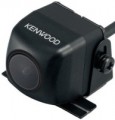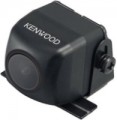Sensor size
The physical size of the photosensitive element of a camera. It is usually measured diagonally and is indicated in inches — more precisely, fractional parts of an inch. The larger the sensor, the larger the size of each individual dot (pixel) on it, the more light enters each pixel, and the easier it is to ensure high image quality with a minimum of noise (especially when it comes to shooting at dusk). However you need to remember that only matrices of the same type and resolution can be compared with each other in size. And a large sensor is not always a guarantee of quality — a lot depends on the rest of the hardware of the camera, the quality of its installation and other factors. However, the large size of the sensor usually indicates a high class camera.
Video resolution (TVL)
Although modern electronics are dominated by digital standards, car reversing cameras still use an analogue signal transmission format. This is due to compatibility requirements: such video allows you to use fairly simple screens. And although its quality loses to digital, it is quite enough for most of the tasks facing this class of auto electronics.
An analogue video signal has a size in horizontal and vertical dots. But since the number of vertical dots has a strictly defined number of 625 (in the PAL and NTSC colour system), resolution is usually indicated only by the number of horizontal dots (TV lines).
In fact, this parameter describes the quality of the image that is displayed directly on the screen connected to the camera. There are models with a value of
480,
500,
520,
540,
560 TVL and even
higher resolution in TVL. This is important for models with wide viewing angles (see below). On the other hand, in order to use all the features of a camera with numerous TV lines, a screen corresponding to these features is also required; For more details on compatibility with the screen, see specialized sources.
Camera angle
The viewing angle characterizes how wide the area of space is captured by the camera lens: the larger
they are, the wider the field of view, the more space is in the frame. In most modern models, it varies from 120° to 170°; this allows good visibility of almost the entire rear hemisphere. There are 180° cameras and even more; they will come in handy if visibility is important to you not only from behind, but also on the sides. But note that some manufacturers indicate the angle horizontally, while others — diagonally.
At the same time, it does not always make sense to chase wide angles. Note that the larger the viewing angle, the more distant, reduced the image looks, the more distortion occurs at its edges. In addition, wide viewing angles require high resolution, which accordingly affects the price of the camera; if the resolution is low, the "picture" may look blurry and small details will be lost on it.
Сolour encoding system
The colour system refers to the format in which colour information is transmitted in an analogue video signal. In modern reversing cameras, the European PAL system or the American NTSC are most often used. It makes no sense to describe them in detail — suffice it to say that for the normal operation of the camera you need a radio tape recorder (or other device with a screen on which the image is displayed) with support for the same colour system. However, incompatibility in this parameter is not fatal — with such a connection, the image will only turn from colour to black and white (in extreme cases, its overall quality will slightly deteriorate).
Signal-to-noise ratio
This parameter describes the total amount of interference in the video output from the camera. The higher the signal-to-noise ratio (that is, the ratio of the useful signal level to the level of extraneous interference) — the better the image will be, the less distortion it will have. The minimum level for modern cameras is considered to be 40 dB — with it, the “picture” is reproduced with minor noise that does not significantly affect its perception. And in the most advanced models, this figure can reach 48 – 50 dB — such an image for the human eye is almost indistinguishable from the perfect one.
Of course, in fact, the quality of the image also depends on the capabilities of the screen on which it is displayed, however, even the best screen will not save a “noisy” camera.
More features
-
Auto exposure. The presence in the camera of the function of automatically adjusting the shooting parameters to the degree of illumination of the scene caught in the frame. Exposure in the classical sense is the amount of light perceived by the photosensitive element of the camera; it can be changed by opening and closing the aperture of the lens, as well as by adjusting the shutter speed of each frame. If the range of these adjustments is not enough, a change in the sensitivity of the matrix can also be used in digital devices. Either way, an underexposed image will look too dark, and an overexposed image will look too bright; both are unsuitable for viewing. However, the process of manually adjusting all the parameters is rather troublesome and obviously inappropriate when driving in a car, especially since the illumination of the picture in the field of view of the lens can change in a matter of seconds. Therefore, most modern cameras have an auto exposure function. Thanks to it, the device itself sets the parameters to the optimal level and changes them when the illumination changes. Note that such automation is not ideal, but in the vast majority of cases it is quite enough for normal visibility on the screen.
-
Auto white balance. The camera has an automatic white balance correction function. Despite the name, this balance concerns not only white color, but also the overall color gamut of
...the image coming from the camera. Without going into details, its meaning can be described as follows: each type of lighting (sunlight, overcast day, fluorescent lamps in the garage, street lights, etc.) needs its own white balance settings, otherwise the colors in the image will look unnatural - too warm or too cold. Auto-correction, on the other hand, relieves the user of the need to adjust the white balance manually - the device itself determines the type of lighting and reconfigures. At the same time, given the specifics of the purpose of the rear and front view cameras, this function is rather a pleasant addition than a practically significant point - after all, it is not the colors of visible objects that are usually decisive when maneuvering, but their location in space.
— Parking labels. Possibility of displaying by the camera on the connected screen of parking marks — a special scale which is superimposed on the visible image in a special way. Such a scale plays the role of a rangefinder: the distance to the object visible on the screen can be estimated by the mark near which it is located, this greatly simplifies maneuvering in tight conditions. In addition, in some models, it also helps to evaluate the dimensions of the visible openings in width. True, for an adequate display of parking marks, the camera must be installed quite accurately - at the optimal height from the ground and at a certain angle to the horizontal; in regular models (see "Installation type"), this usually does not cause difficulties, but universal models may require ingenuity and painstaking work. We also note that even with an ideal installation, the accuracy of the parking marks will be far from absolute. However, they can be a very useful addition to a "clean" camera image.
- DVR function. The ability to shoot not only in the mode of broadcasting an image to a multimedia screen, but also to record the situation around the car on an external data drive. The DVR function is implemented in advanced models with a separate data processing unit, the design of which provides a slot for a memory card for storing captured video materials.
- Top view. The top view gives you full control over the situation around the car and makes it easier to maneuver in tight spaces. Also, the top view allows you to better see obstacles in blind spots and improves the safety of reversing parking in tight spaces. This feature is found in surround view systems. The projection of the top view is formed by processing images from cameras dispersed around the perimeter of the vehicle.
- Water protection. The presence in the design of the chamber of protection against moisture ingress. This feature is almost mandatory for outdoor models, as they will inevitably be exposed to rain, snow, spray from wheels, etc. In some cases, the manufacturer even indicates the level of this protection. However, even without it, you can be sure that nothing will happen to the camera even in the rain.
- Remote control. A remote control is included with the camera. Unlike conventional household devices, wired remote controls are most often used in automotive electronics; reversing cameras are no exception. This is due to the fact that the wire in the car is often not only cheaper, but also more convenient than an IR sensor or a radio channel. We also note that this function is usually found in premium models that have additional features - for example, switching the viewing angle.
